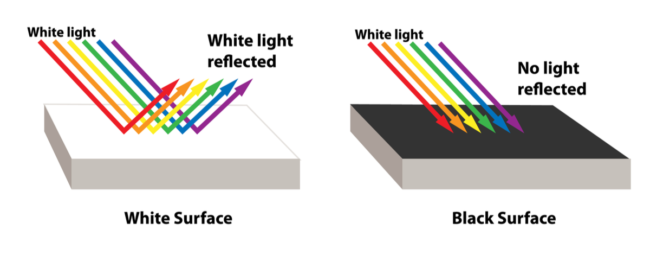
It’s important to understand the solar reflectance index when selecting roofing materials to lower energy cooling costs. First, let’s discuss solar reflectance index testing and the best practices for determining your ideal roof technology.
Solar Reflectance Index, Defined
The most effective way to measure cool roof efficiency is by calculating its solar reflectance index (SRI). Essentially, SRI is a coolness indicator tool that compares a roof’s surface temperature in heavy sunlight to the temperature of a dark black or bright white roof. For example, the SRI of a solid black roof is 0, while the SRI of a solid white roof is 100.

Two factors play a crucial role in determining these values: solar reflectance and thermal emittance. Overall, these calculations are used to make high-accuracy estimates of a material’s surface temperature under specific conditions. Thus, it is an incredibly useful tool for urban heat island (UHI) effect mitigation.
Best Practices for Solar Reflectance Index Testing
When choosing roofing materials for your next building project, don’t forget about SRI. Solar reflectance index testing is a helpful tool for determining your ideal roof technology.
Stay Up to Date on LEED SRI Requirements
To get your LEED project certified, you must provide SRI values for all your roofing materials, paving materials, and shade-giving structures. The current LEED rating system is LEED v4, formerly LEED 2009. To meet LEED v4 compliance, your roofing material must follow the following requirements.
- Initial SRI of 29 or higher (Steep sloped roof)
- Initial SRI of 78 or lower (Low sloped roof)
Below you will find links to the most current LEED rating system requirements.
- LEED v4 for Building Design and Construction
- LEED v4 for Interior Design and Construction
- LEED v4 for Building Operations and Maintenance
- LEED v4 for Neighborhood Development
- LEED v4 for Homes and Midrise
Consider SRI Values for Various Building Materials
It’s essential to understand the role that solar reflectance index testing plays in a new roofing project. When choosing building materials, it’s important to research and educate yourself on the SRI values of various products. Below are some examples of average SRI value ranges:
- Asphalt Shingles: 3-26
- Concrete Pavers: 5-85 (SRI varies considerably across concrete paver products)
- Bamboo: 35-48
- Natural Stone: 54
- White Metal Roof: 67
- White Concrete Tile: 73
- White Cement Shingles: 77
This information is gathered through extensive solar reflectance index testing. Now, look at some of the average values based on material color.
- Light-Medium Grey Concrete – “Standard grey” concrete can have an average SRI value ranging from 35-86.
- Mid-Range Grey, Beige, Tan – These colors are typically very close to standard grey concrete, if not 5% higher.
- Dark Grey, Brown, Black – These dark colors are on average 10-22% hotter than standard grey. In general, dark-colored materials have poorer solar reflectance than light-colored materials.
- Light Grey, White, Cream – The “cool colors” in this category cultivate 5-20% less heat build-up than concrete.
Do Your Research
Solar reflectance index should never be an afterthought when preparing a new commercial or residential building. Take into account these design considerations before starting construction.
- Are LEED points for heat island reduction important to your design goals?
- Are you in a northern climate or shady area? If so, use darker colors.
- Maintenance is key to preserving high SRI—how committed are you to project upkeep?
- Know that SRI values will change over time as any material ages, weathers, and discolors.
- What is in the surrounding location? Are there abundant trees, water, or other objects on the landscape?
- Will people or animals be barefoot on the surface, like a swimming pool area, for example?
- High-value SRI building materials used in colder climates can potentially increase heating demand due to low energy absorption
- Keep in mind that cool materials are increasingly advantageous as the ambient temperature rises.
Finding the Right Partner for Your Cool Roof Project
Partnering with a knowledgeable cool roof technology manufacturer is the first step to getting your project LEED-certified. At Kaneka Energy Management Solutions, we integrate effective energy generation into various types of commercial properties through innovative dual-function building materials. Our high-quality building materials offer environmental benefits as well as financial benefits in the form of reduced energy consumption and greenhouse effect.
We hope you found the information in this article useful and that it helps your organization achieve the benefits of cool roofing materials. At Kaneka, our company mission is to help building owners develop and implement the best available technologies and BIPV solutions. As your trusted partner, we’ll help you make the most of your investment.
Contact us online today for more information on our cool roof and bi-facial technology for commercial building projects.